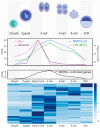Host Gene Regulation by Transposable Elements: The New, the Old and the Ugly
- PMID: 32993145
- PMCID: PMC7650545
- DOI: 10.3390/v12101089
Host Gene Regulation by Transposable Elements: The New, the Old and the Ugly
Abstract
The human genome has been under selective pressure to evolve in response to emerging pathogens and other environmental challenges. Genome evolution includes the acquisition of new genes or new isoforms of genes and changes to gene expression patterns. One source of genome innovation is from transposable elements (TEs), which carry their own promoters, enhancers and open reading frames and can act as 'controlling elements' for our own genes. TEs include LINE-1 elements, which can retrotranspose intracellularly and endogenous retroviruses (ERVs) that represent remnants of past retroviral germline infections. Although once pathogens, ERVs also represent an enticing source of incoming genetic material that the host can then repurpose. ERVs and other TEs have coevolved with host genes for millions of years, which has allowed them to become embedded within essential gene expression programmes. Intriguingly, these host genes are often subject to the same epigenetic control mechanisms that evolved to combat the TEs that now regulate them. Here, we illustrate the breadth of host gene regulation through TEs by focusing on examples of young (The New), ancient (The Old), and disease-causing (The Ugly) TE integrants.
Keywords: Intracisternal A-type particle elements; KRAB-associated protein 1; X chromosome inactivation; endogenous retroviruses; epigenetic repression; gene regulation; genomic imprinting; position-effect variegation; transposable elements.
Conflict of interest statement
The authors declare no conflict of interest. The funders had no role in the design of the study; in the collection, analyses, or interpretation of data; in the writing of the manuscript, or in the decision to publish the results.
Figures





Similar articles
-
Transposable Element Exaptation into Regulatory Regions Is Rare, Influenced by Evolutionary Age, and Subject to Pleiotropic Constraints.Mol Biol Evol. 2017 Nov 1;34(11):2856-2869. doi: 10.1093/molbev/msx219. Mol Biol Evol. 2017. PMID: 28961735 Free PMC article.
-
The majority of primate-specific regulatory sequences are derived from transposable elements.PLoS Genet. 2013 May;9(5):e1003504. doi: 10.1371/journal.pgen.1003504. Epub 2013 May 9. PLoS Genet. 2013. PMID: 23675311 Free PMC article.
-
Roles of transposable elements in the regulation of mammalian transcription.Nat Rev Mol Cell Biol. 2022 Jul;23(7):481-497. doi: 10.1038/s41580-022-00457-y. Epub 2022 Feb 28. Nat Rev Mol Cell Biol. 2022. PMID: 35228718 Free PMC article. Review.
-
Epigenetic regulation and functional exaptation of transposable elements in higher plants.Curr Opin Plant Biol. 2014 Oct;21:83-88. doi: 10.1016/j.pbi.2014.07.001. Epub 2014 Jul 25. Curr Opin Plant Biol. 2014. PMID: 25061895 Review.
-
Characterization and functional annotation of nested transposable elements in eukaryotic genomes.Genomics. 2012 Oct;100(4):222-30. doi: 10.1016/j.ygeno.2012.07.004. Epub 2012 Jul 16. Genomics. 2012. PMID: 22800764
Cited by
-
Growth of Biological Complexity from Prokaryotes to Hominids Reflected in the Human Genome.Int J Mol Sci. 2021 Oct 28;22(21):11640. doi: 10.3390/ijms222111640. Int J Mol Sci. 2021. PMID: 34769071 Free PMC article.
-
Recognize Yourself-Innate Sensing of Non-LTR Retrotransposons.Viruses. 2021 Jan 12;13(1):94. doi: 10.3390/v13010094. Viruses. 2021. PMID: 33445593 Free PMC article. Review.
-
Repeatome-Based Phylogenetics in Pelargonium Section Ciconium (Sweet) Harvey.Genome Biol Evol. 2021 Dec 1;13(12):evab269. doi: 10.1093/gbe/evab269. Genome Biol Evol. 2021. PMID: 34893846 Free PMC article.
-
Editorial Overview: Endogenous Retroviruses in Development and Disease.Viruses. 2020 Dec 16;12(12):1446. doi: 10.3390/v12121446. Viruses. 2020. PMID: 33339171 Free PMC article.
-
Loss of heterochromatin and retrotransposon silencing as determinants in oocyte aging.Aging Cell. 2022 Mar;21(3):e13568. doi: 10.1111/acel.13568. Epub 2022 Feb 15. Aging Cell. 2022. PMID: 35166017 Free PMC article.
References
Publication types
MeSH terms
Substances
LinkOut - more resources
Full Text Sources
Research Materials
Miscellaneous

